If you’re planning to spend 3 days in Lisbon, Portugal this Lisbon itinerary and guide will help you explore the city like a local, save money and get the most out of your Lisbon citybreak.
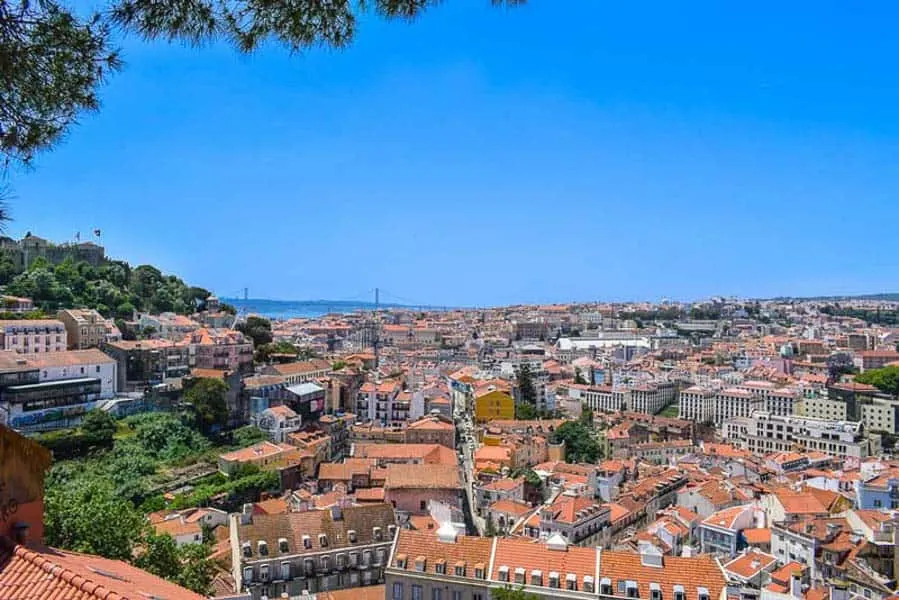
This post may contain affiliate links, which means that we may earn a small commission, at no extra cost to you, for qualifying purchases. More info: disclosure.
This guest post comes from Alex at Earthosea.com. who specialises in travelling on a budget in a sustainable way. Alex spent 2019 living in Lisbon, Portugal which means her Lisbon itinerary combines local knowledge with budget travel – a pretty good combination in our book.
3 Days in Lisbon – a detailed guide
Contents
Lisbon, located at the banks of the river Tagus, perfectly contrasts the new and modern with the old and traditional. This vibrant city is home to more than 2 million people and welcomes even more tourists every year.
The city is culturally rich with a history dating back to the second century when it was founded by the Celtic tribes inhabiting the region. During the Middle Ages, Lisbon witnessed the great religious wars during the Reconquista period before reaching its peak during the Age of Discoveries. Lisbon was the connection between the new and the old world and, during that time, became one of the richest cities in the world.
Nowadays, Lisbon is still as enchanting as it ever was and remains a magnet to tourists, not least for a wide range of things to see and do for the budget conscious visitor. There are many famous landmarks in Lisbon, both historical and cultural, that deserve attention, not to mention the nature parks and beaches that surround the area.
There’s a fabulous food scene. Lisbon is a city that perfectly combines culture, city life and nature in a unique way. Use this 3 days in Lisbon itinerary to plan your perfect visit.
Things to know before going to Lisbon
- The sun is harsh – Make sure to get a sunscreen and apply it regularly. We recommend Altruist, an ethical, premium quality sunscreen at an affordable price developed by dermatologists which is also reef safe. Take a hat and a reusable water flask that’ll keep your water nicely chilled.
- Wear comfy shoes. This is a must – the streets in Lisbon are steep and there are lots of hills that require climbing.
- Carry cash – but not too much. This is especially applicable for the small shops and cafes in Alfama. There are few ATMs and it is sometimes impossible to pay with a card.
- Beware of pickpockets, especially in public transportation or crowded places.
- Avoid withdrawing from Euronet ATMs – and by avoid, I mean don’t. These ATMs are going to charge you as much as they want or 7.5% to 20% over on what you withdrew.
- I use my Wise account which I keep topped up with Euros and US$. I can use it as a debit card overseas without expensive charges and with realistic exchange rates. I wouldn’t be without it.
- Try Pastéis de Belém and Queijadas, which are considered to be the best pastries in Portugal.
- Drink ginjinha, but not too much – this cherry liquer is wonderful but it’s potent!
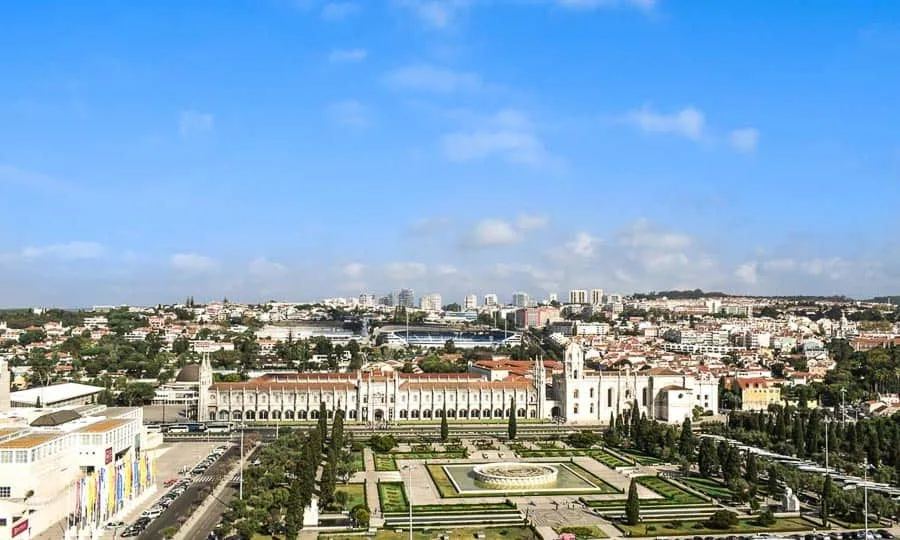
How to get to Lisbon from the airport
Getting from Lisbon airport to the city centre is relatively easy and cheap. One option is the Aerobus which costs around €4 euros one-way and departs every 20-minutes. A two-way ticket costs €6 euros but is only valid for 24 hours. Lisbon airport is just 7km from the city.
Another option is the metro – Lisbon airport has a station (subway) with a direct line to the city centre.The ‘Aeroporto – Saldanha’ line will get you to downtown Lisbon in around 20 minutes. At Alameda switch to the green line, which will take you to Rossio Square, which is in the heart of the city. See below for more details on ticket prices and the Viva Viagem card.
If you’d like a treat then pre-book a private transfer which costs around €21 for up to four passengers.
How to get around Lisbon
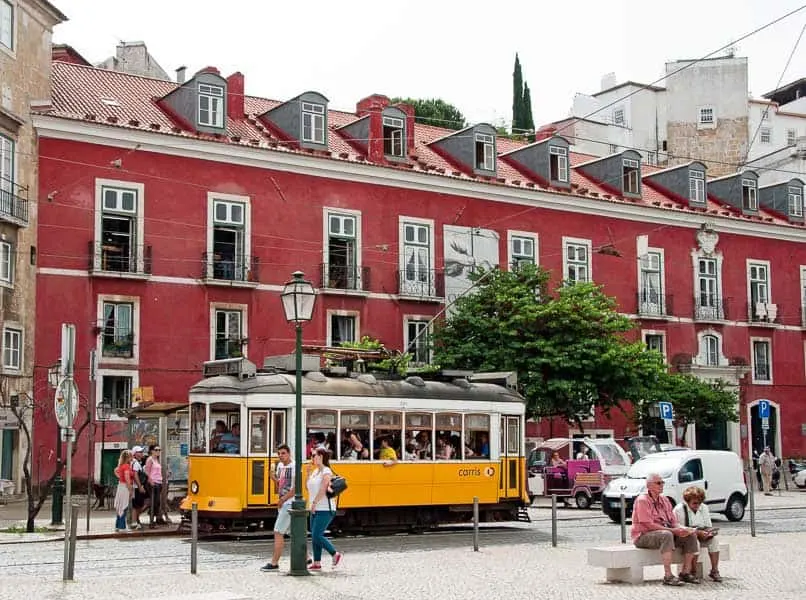
When it comes to public transport, Lisbon is a pretty developed city. Within the city one can easily move around via trams, trains, metro, buses and even lifts.
The most convenient way of travelling in Lisbon is the metro. The network is an easy way to move around the city with many stations placed at convenient locations. Get your rechargeable card when you arrive at the airport and use it for your airport transfer too.
A single ticket is €1.50 and is valid for one hour but you will also need to purchase a re-chargeable card Viva Viagem for €0.50. You can top this up and use it throughout your visit. It’s €6.30 for a 24-hour pass. It can be used throughout the Carris network on trains, trams, buses and lifts.
The Viva Viagem card can also pay for a ferry ride to the other side of Lisbon for as little as €3 euros. You’ll need to use the contactless machine to validate your card each time you travel and wait for the gates to open.
If you prefer a more comfortable way of travelling around make sure to use either Bolt or Uber, which are cheaper and safer options compared to taxis. The start tariff in Lisbon is €3.50 euros and €0.47 for every kilometre.
For example, if you need to reach Belem district from the city center you can catch the train from Cais do Sodre (Linha de Cascais). This train is the one that takes tourists to Cascais, but you can get off at Belem train station. The journey takes around 10-15 minutes.
How to save money on your visit to Lisbon
The flexible Lisbon Card is a good option for saving money on your visit to the city. It includes unlimited travel on city transport, including airport transfers, and entry fees to 39 different attractions. There are also a range of discounts at many shops, eateries and attractions.
It’s worth comparing the cost of the pass against the individual entry charges and public transport before you buy. In most cases it’ll save you money but occasionally it won’t so do your sums beforehand. 24, 48 and 72-hour tickets are available.
Where to stay in Lisbon
The best places to stay in Lisbon are around the city centre, but not actually in it. Lisbon is a noisy city, especially during the summer months, when the crowds party until dawn. Choose a more secluded district which is easily walkable to the party areas like the upper parts of Alfama, Bairro Alto, Baixa and Rossio.
The best B&B is the Chalet D´Ávila Guest House which is close to the airport, but is a couple of steps from the metro. It is a very stylish guest house, which provides delicious breakfast.
Another option is the Rossio Boutique Hotel which is a couple of minutes away from many landmarks of Lisbon. It has been recently renovated and is one of the most stylish places to stay in Lisbon.
If you’re looking for a modern 5* then the EPIC SANA Lisboa Hotel in the upscale area of Amoreiras will suit you. The EPIC SANA has an indoor pool, rooftop infinity pool with views over the city and a buffet breakfast (which serves those gorgeous Pasteis de Nata custard tarts). It’s located about a 25 minute walk from the centre of the city and just a few minute’s walk from Marquês de Pombal metro station which is a ten minute walk away.
If hostels are more your thing then this guide to hostels in Lisbon will be very helpful.
Ready to plan your 3 days in Lisbon? These planning tools might help…
- To get the best deals on flights, compare cheap prices with Skyscanner flight comparison site
- Book your airport transfers with Welcome Transfers
- Find the perfect place to stay on Booking.com
- Compare prices for your car hire
- Explore your destination through local experiences
- If you think you need a visa check with iVisa
- Plan your trip with maps and guide books
- I use a Wise account multi-currency debit card. Easy to top up, low fees and better exchange rates.
- And, finally, please don’t forget to protect you and your trip with travel insurance. I’m very happy with my Heymondo travel insurance.
Where to eat in Lisbon
Probably the best traditional restaurant in Lisbon is Pateo 13 which is set in the heart of Alfama. It offers incredible fish meals and the dishes are always fresh and tasty. You even have the option to choose the fish that you want to be cooked for you. The restaurant is not expensive, but there might be lines of people waiting to be seated.
Where: Pateo 13, St. Stephen’s Boardwalk N ° 13, 1100-502 Lisbon

Another place to try the incredible Portuguese cuisine is the Mesa De Frades, which is located in an old chapel and known for its fascinating Fado shows. The price per meal there is higher, but the live performance is absolutely worth it.
So, now that we’ve got the practical aspects of your trip covered let’s get onto your Lisbon 3 day itinerary…
Day 1 – Exploring Lisbon’s Culture
The first day in Lisbon is dedicated to diving deep into the culture of the city and Portugal. You’ll explore Lisbon’s oldest district and then slowly descend to the riverside to explore its street art and museums.
Alfama
Alfama is the oldest district in Lisbon and is known as the brightest and most cheerful part of the city. This laid-back part of the city is definitely a must-see for its narrow steep streets leading to various miradouros overlooking the city.
Some of the best viewpoints are Miradouro da Senhora do Monte and Miradouro da Graça, which have fabulous views over the city. Miradouro Santa Luzia and Portas do Sol reveal romantic vistas over the old part of Lisbon.
The district of Alfama is known for celebrating most of the Portuguese festivals and numerous traditions. It’s highly likely that during your visit there will be some sort of event or fiesta.
Lisbon’s oldest neighbourhood is home to most of the city’s churches and cathedrals. This is the place where the oldest religious building has been built some 2,000 years ago – Sé Catedral de Lisboa.
The cathedral is one of the highlights in the city, although it is often overlooked by tourists. Inside, the cathedral is not as impressive as other religious buildings around Portugal. However, if you decide to explore its cloister and treasure, you’ll be stunned by their abundance.
Along with that, you will get the chance to climb to its top and enjoy a rarely seen view over the old part of the city.
If you don’t fancy walking up all those hills in Alfama then this e-bike (electric bike) tour takes out all the effort and takes you off the tourist path. Check rates and availability.
Museu Nacional do Azulejo
Close to the riverside of river Tagus is the National Tile Museum, which is prominent with its incredible collection of all sorts of tiles. Most importantly, the museum is housing a very important collection of tiles, known as Azulejos.
The Azulejo tiles are hand-painted tiles with artistic expression, which highly distinguishes the Portuguese culture. In addition, the museum follows the timeline of tile creation and painting. Various periods are displayed on tiles, such as Reconquista, Age of Discoveries and many more.
The National Museum of Tiles is housed in the former Madre de Deus Convent, which is a beautiful convent dating back to the fifteenth century. Its interior is absolutely astonishing, as it is covered in blue azulejos and golden ornaments. The Madre de Deus Convent is surely one of the most praised religious buildings in Portugal.
If you want to learn more about Azulejos then you can enjoy a fun and interesting day learning all about the famous Portuguese tiles. First visit a craftsman’s tile workshop before taking in the National Azulejo Museum and a tour of some of the most beautiful tile artwork in Lisbon. Check rates and availability.
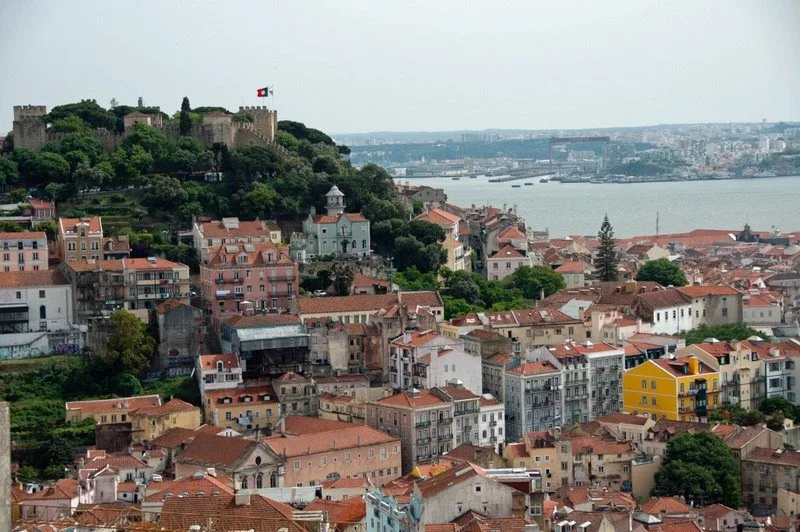
São Jorge Castle
The São Jorge Castle is built on the highest hill in Alfama and has a perfect view over the region. The castle has witnessed many battles and wars over the ages, especially during the Reconquista. Its main purpose was to protect the people of Lisbon ,and the city itself, from any attacks which were frequent in days gone by.
Nowadays, the São Jorge Castle is prominent for its staggering defensive walls and massive fortifications. At the top, there is a historic museum, which sheds some light on how people were living back then in the castle. Apart from that, the castle is probably the perfect place to observe the charming city of Lisbon.
Get skip the line tickets and a short guided tour of the castle. Check rates and availability.
Day 2 – Exploring Lisbon’s Historic Centre
The second day in Lisbon is dedicated to exploring its historical landmarks, starting at the riverside, then to the heart of the city and exploring it from within.
Comercio Square
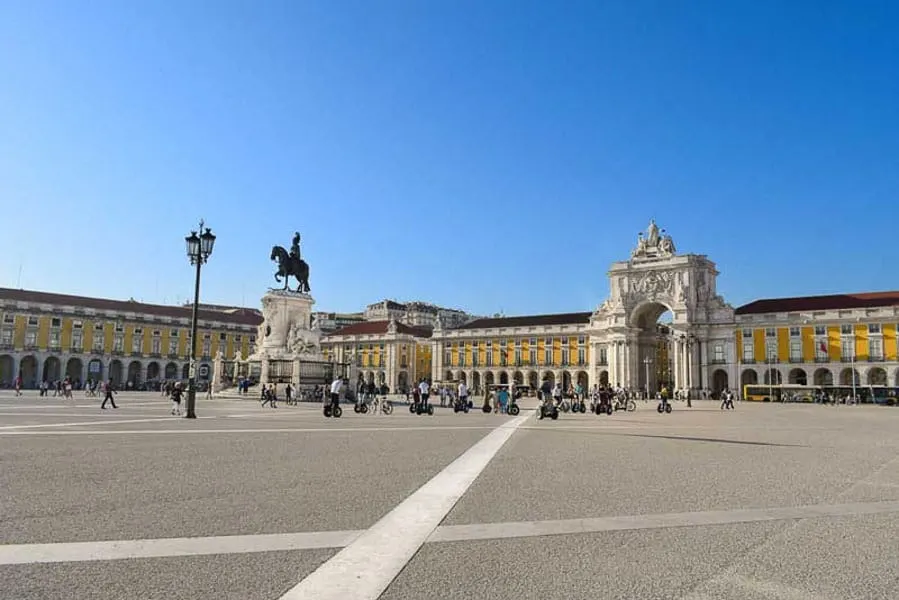
Exactly at the waterfront of the Tagus river is the Praça do Comércio, also known as the sunniest square in Portugal. Praça do Comércio was the seat of the Portuguese royal family for many years, until a devastating earthquake and tsunami hit Lisbon in 1755.
After that, the royals moved to their residence in the district of Belem. Although, the palace and square were destroyed, they were quickly rebuilt and painted bright yellow, which only adds to the charm of it.
If you want to get a birds-eye view over Praça do Comércio climb the Arco da Rua Augusta. It is easily done by paying a fee of €4 euros and using the elevator.
Whilst up there you will get an insight on how clocks work. This is due to the display of many old clocks as well as the mechanism of the huge clock that is set on the arch. Get skip the line tickets for Arco da Rua Augusta.
Carmo Convent
Carmo Convent is another religious building that has been prominent as being the royal family’s favourite religious resort. Unfortunately, the Carmo Convent was demolished in the eighteenth century by the tsunami that hit Lisbon.
The convent has never been restored or rebuilt, but is left as a memorial and reminder of the devastation that hit the city.
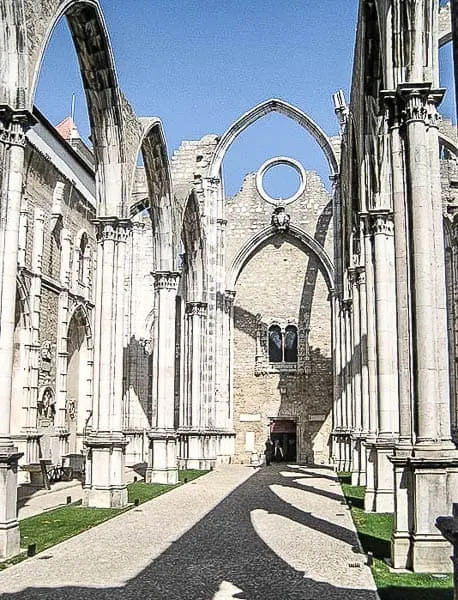
These days, Carmo Convent, or what is left of it, is one of the most well-known historical and religious landmarks in Lisbon. Although, there are only pillars and arches left, suggesting the size of the convent, there is a magnetic and powerful vibe to feel.
There is also a museum, which houses a couple of well-preserved statues from the convent, along with books and mummies. To enter the Carmo Convent it costs €4 euros. See the Carmo Convent museum website for timings and opening hours.
Explore Lisbon e-bike on this 3 hour guided tour around the city.
Santa Justa Lift
Lisbon is a city full of steep hills, which require a bit of help to climb. In the nineteenth century the locals decided to build a lift so they can move easily through Lisbon’s steepest hill. This beautiful lift is now known as the Santa Justa Lift and has become a tourist attraction.
The Santa Justa Lift is easily recognized due to its Gothic arches and geometric patterns. In addition to that, it stands taller that most of the residential buildings in the area. This helps for revealing some of the best vistas in Lisbon. To access the Santa Justa Lift you will have to pay a price of €5, which covers a two-way ticket.
Book this Lisbon histories, stories and lifestyle walking tour which includes a visit to Carmo Convent
Rossio Square
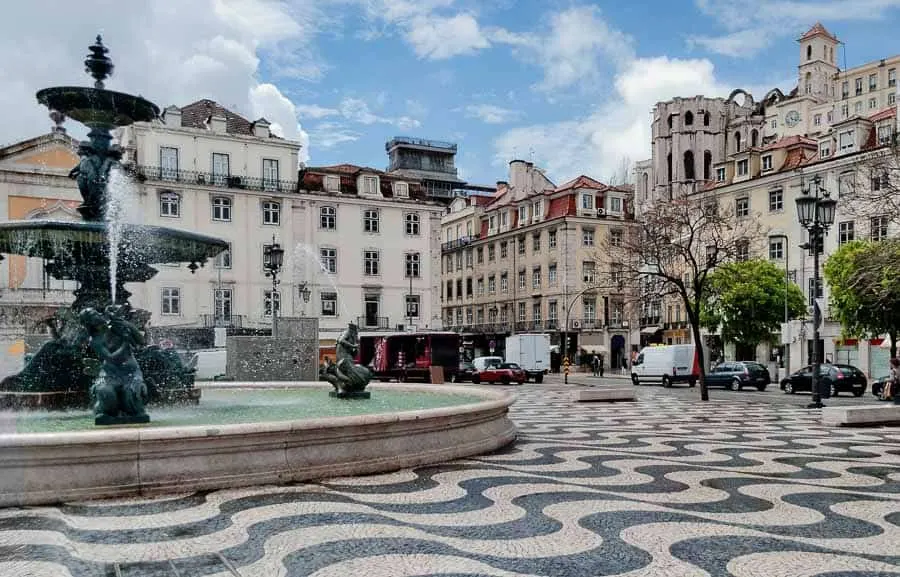
Rossio Square is probably the favourite spot for the locals. In the past, Rossio square was gathering all of the people of Lisbon for various events such as celebrations, bullfights and even executions.
However, when the tsunami hit the city, it destroyed everything, including the square. Nevertheless, Rossio square was rebuilt with wavy mosaic patters that might hypnotize you if look at them a lot.
In addition to that, a statue of Pedro the Fourth, King of Portugal has been installed along with two bronze fountains to add to the Romantique architecture.
This fabulous tuk tuk tour includes Lisbon’s top sights. Check rates and availability
Day 3 – Exploring Lisbon’s Great Discoveries
Your final day of your 3 days in Lisbon see you heading to the district of Belém, which is known for being influenced highly by the Great Discoveries. The district was also the place where all of the voyagers departed from or arrived to and so it has a significant importance in relation to the Great Discoveries.
Jeronimos Monastery
The Jeronimos monastery is known for its beautiful Gothic architecture and is considered to be one of the most extravagant monasteries in Portugal. It was built in the fifteenth century and is richly decorated with lots of arches and pillars, accompanied by stone carvings.
In 1983 the monastery was classified as a UNESCO World Heritage Site, which has boosted its significance.
Some of the most interesting parts of the monastery are its cloisters that are full of all sorts of golden treasures. Along with that, the monastery is also home to the tomb of Vasco da Gama, since he was a frequent visitor to the monastery.
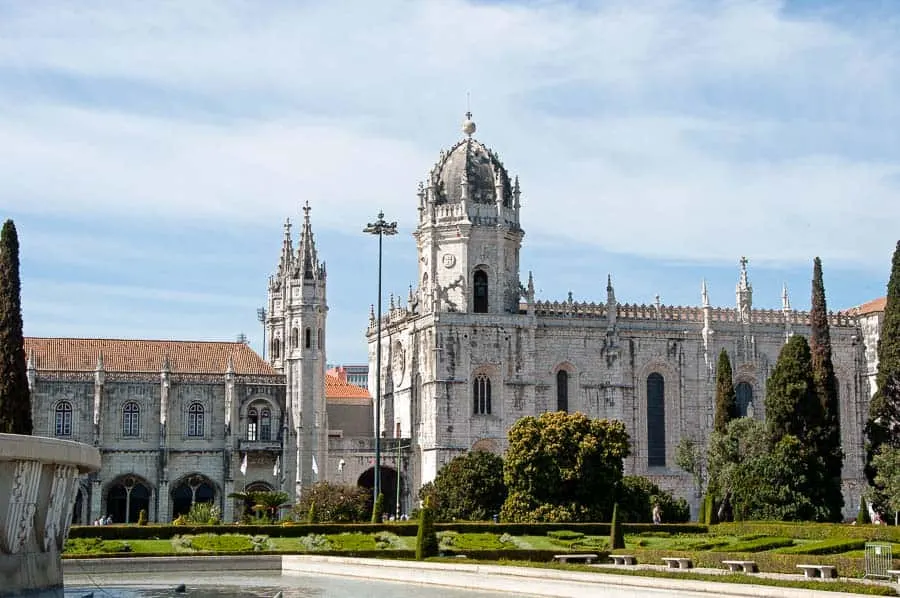
The Jeronimos monastery was a very important stop for all voyagers before they embarked on their journeys at sea.
Most of them would stop to pray and sleep at the monastery on the night before they sailed. It’s therefore no surprise that the monastery has become one of the wealthiest and historically important monasteries in Portugal.
Jeronimos monastery is open from Tuesday to Sunday. However, bear in mind that the lines of waiting people can be huge. Thus, it is recommended to go there as early as possible or buy a ticket in advance to save you time.
Momument to the Discoveries
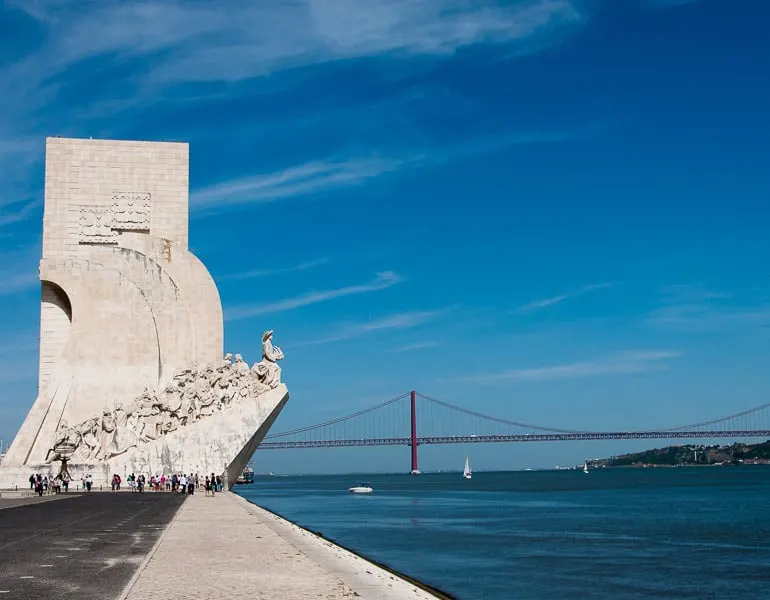
This imposing monument has the purpose of honoring the great Portuguese explorers, among which is Vasco da Gama. It was built in the beginning of the twentieth century and is 52 meters high.
If you climb up inside to the top it reveals an astonishing view over the estuary of Tagus river. Once at the top, you’ll enjoy a beautiful view of the ocean, the river and the historical monuments, along with a map of the world.
The map that was created in front of the Monument of the Discoveries shows all of the discovered lands by the Portuguese explorers along with the year of discovery.
To get to the top of the monument, simply enter it and after paying a fee of 6 euros you will be elevated to its top.
Belém Tower
Belém Tower is considered to be the symbol of Lisbon for many reasons. First, for its notable Romantique architecture, which sets it apart from all of the other landmarks around it. Secondly, for its historical importance related to the Age of Discoveries.
It’s not surprising that Belém Tower been classified as a UNESCO World Heritage Site.
The tower of Belém was built as a defensive tower to protect the city from any sea attacks or pirates. It was also the place where all of the explorers departed on their voyages around the world. Get your Belem Tower tickets in advance to save time.
I hope you’ll use this guide to help plan a fabulous 3 days in Lisbon. Have a look at our other posts about Portugal. You might want to add on a couple of days in Porto or even spend more time in Lisbon.
About Alex
Alex is a blogger at EarthOSea who has travelled extensively around Europe for the past 3 years. She lived in Portugal in 2019 where she got more familiar with the Portuguese culture, traditions and language.
Alex’s speciality is travelling in a sustainable and less harmful way to the environment. She is focusing more on ways to travel on a budget or value-for-money. She loves hiking and discovering uncharted islands, but also loves staying at the beach with a book in hand.
Love it? Pin it!

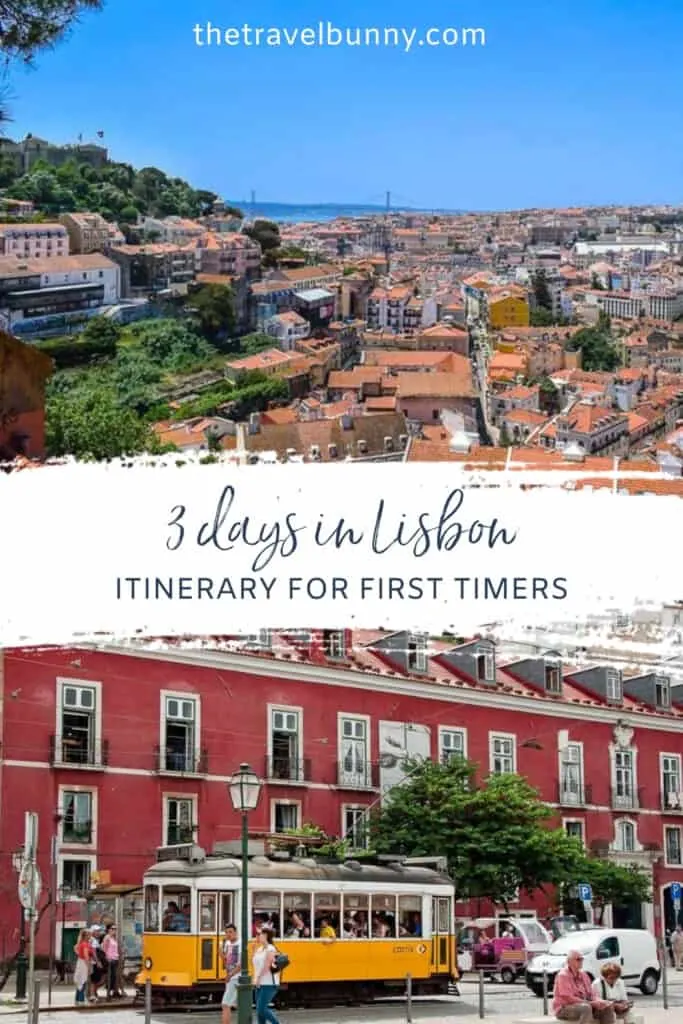

Suzanne Jones is a full-time travel blogger and writer at The Travelbunny website which she started in 2011 during her time as a professional travel planner. This serial traveller enjoys exploring new destinations, culinary encounters and the outdoors. When she’s not indulging her wanderlust or writing about her adventures you’ll most likely find Suzanne, camera in hand, enjoying coastal walks on England’s South Coast.
Suzanne also runs Hello Sussex a website which showcases the best of East & West Sussex. Read more about Suzanne here…




Christina C
Tuesday 2nd of March 2021
I loved Lisbon, and the FOOD! Oh my goodness, I never knew it was a foodie's dream! Oh, and the Port, and the architecture! Yes, a few days is a good primer so that you can plan a longer trip the next time! Thanks for this great guide!
Suzanne Jones
Tuesday 2nd of March 2021
It's a fabulous city. I must have eaten my body weight in Pasteis de Nata during my visit - absolutely delicious!